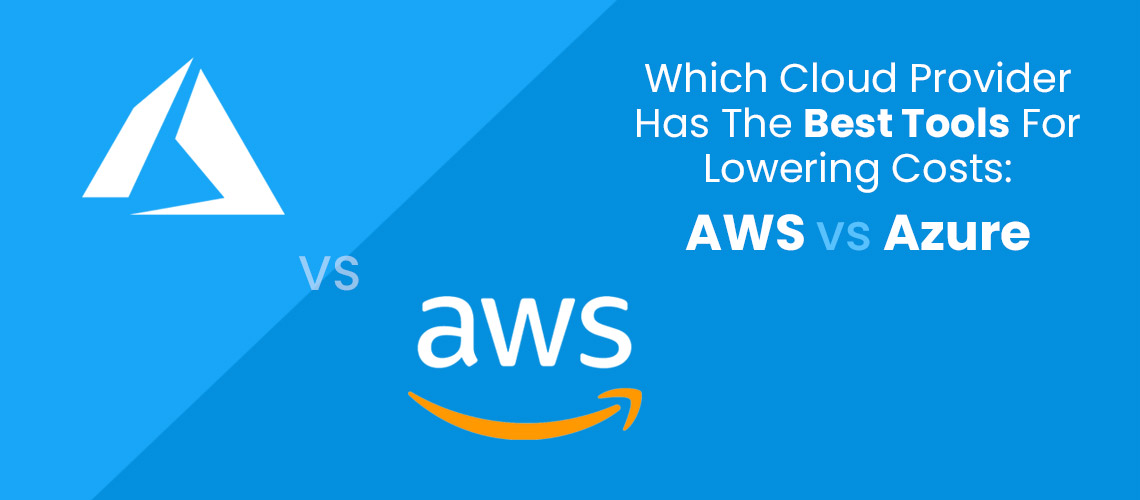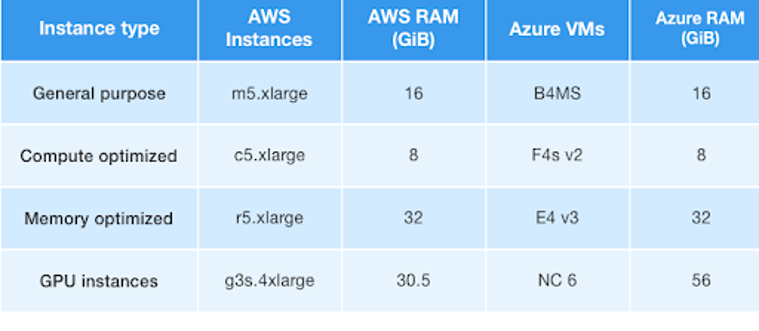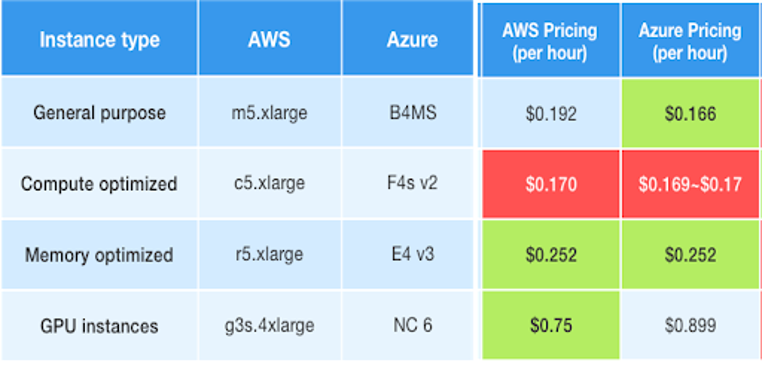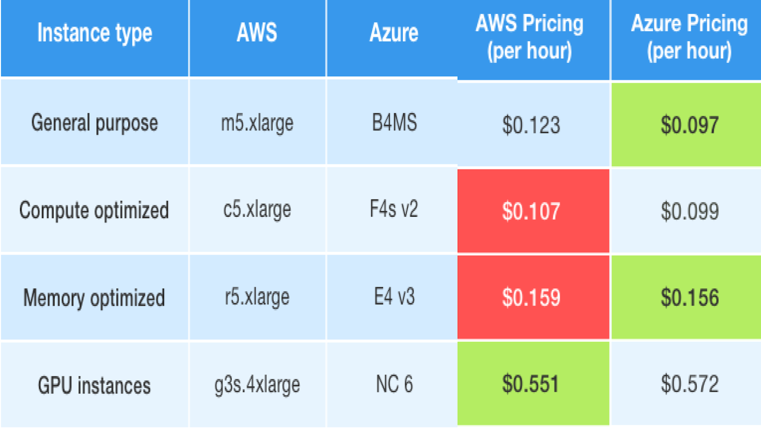
Which Cloud Provider Has The Best Tools For Lowering Costs: AWS vs Azure
Comparing Azure vs AWS pricing has always been difficult due to the frequency with which prices change. However, even though a pricing comparison may only have short-term value in terms of what you will pay today for cloud services, comparisons can reveal price differences you may not have previously identified. Also, it helps you to estimate the budget of your software development project.
On average, compute resources represent 75-80 percent of an organization’s cloud spend. Because computer instances are the major driver in the price you pay, we are going to compare the pricing of Instances/Virtual machines: AWS EC2 vs Azure VMs.
While looking through the pricing of the instances you see terms like $0.0XX per instance per hour, etc. You might think how the pricing comparison would be helpful to reduce the cloud bill. Let’s understand it with an example of Netflix. It uses AWS for its video streaming services.
Cloud comparison between AWS vs. Azure:
- Amazon Web Services – Amazon's offerings are unprecedented with a massive tool collection that continues to expand steadily. However, its cost structure may be frustrating, and its particular emphasis on public cloud instead of hybrid cloud or private cloud suggests inter-operating with the data center is not the highest priority for AWS.
- Microsoft Azure – A near rival to AWS with a cloud architecture that is highly competent. If you're a company client, Azure speaks your language – as Microsoft, few companies have the market history (and help for Windows). Azure understands that you are already operating a data center and the Azure architecture is working hard to communicate with data centres;
The four areas of comparison are as follows:
- Compute
- Database & Storage
- Networking
- Pricing
Compute, databases, storage, and networking
AWS Offerings
- The EC2 instances are the main solution of AWS for computing. With a large range of choices, it can be customized easily. It also provides similar services for device delivery, the Elastic Beanstalk, AWS Lambda and Autoscaling, and the EC2 Container service.
- AWS storage comprises the Elastic Block Storage (EBS), Import/Export large volume data transfer service, Elastic File System (EFS), Simple Storage (S3), Glacier archive backup and Storage Gateway, which works with on-premise environments.
Azure Offerings
- Microsoft's solutions include the Azure Blob storage block, central Azure Storage software, and Queue, Table, and File storage. Offers Site Restore, Import Export, and Azure Backup.
Azure & AWS Offerings
a. Azure & AWS usually deliver impressive networking features including on-premise access and automatic server load balancing.
b. They endorse relational databases including Redshift, Amazon Relational Database Service, Oracle SQL Server, Google Cloud Storage, and Google Bigtable, Amazon DynamoDB, and Microsoft DocumentDB NoSQL databases.
Features
Features are an interesting factor to compare.
Although Azure & AWS both cover data analytics & visualization, the majority believe that Azure is the most advanced in this field. In fact, each has their own way of classifying the different components, so start with the requested proposals, and then collaborate with partners to find the best solutions. Before settling on the network, a company ought to concentrate on one first reality to maintain the growth pace when transitioning to the cloud, realizing likely more economical and effective alternatives. Where, in the first case, it's all important how the market needs productivity or fair price, all these are the later focus. And instead between those two dependent systems you select.
- In terms of flexible service, AWS has the broadest cover areas. In China Amazon has also built one dedicated data center. And AWS also provides the widest variety of resources in storage, computation, analytics, web, internet, networking, management software, developer tools, protection, IoT and business apps. On the other side, Azure appears to be a cohesive hybrid cloud. But for the longest period AWS has been present. When deciding, first, you ought to reflect on your company cycle to prepare for consistency. The choice then rests in determining whether the company wants to grow globally or in terms of versatility of operation.
- Keeping up with emerging technologies, both vendors have provided deep learning software and certain state-of-the-art development apps such as serverless computation (Azure functions, AWS lambda functions) and IoT. To develop a smartphone app, consumers can plug into any cloud infrastructure or even construct a high-performance computing framework, based on their needs. Of course, both vendors are powerful in machine learning, because they can rely on internal knowledge from deep wells.
- AWS & Microsoft Azure, both offer mostly similar basic capabilities around flexible compute, networking and storage. Both share typical elements of a public cloud: autoscaling, self-service, and instant provisioning, plus compliance, security, and features of identity management. They’ve all invested a lot in their cloud services, and have big parent companies to continue doing so. This has given us analytics offerings that are more mature. For instance, with Hadoop clusters, support is provided by Azure (HDInsight) and AWS (Elastic MapReduce).
- Amazon uses various protocols and titles when breaking down the goods in the cloud. From processing, storage, servers, game-development relocation and more. There is also a large degree of classification when it comes to AWS remedies. Such technologies include databases, backup and storage, archiving, storage from earthquakes, DevOps, and Big data.
Azure often offers a vast variety of functionality, but by providing different functions depending on the amount of customers, they add importance. Take their Company (EA) arrangements. This helps broad companies to gain profits from committing use to Azure. The cons include more affordable rates and more convenient billing. Microsoft's Azure Machine Learning Lab helps expert engineers to create, check, and distribute algorithms, as well as an off-the-shelf API marketplace.
AWS vs. Azure : Major Pros and Cons
Most analysts suggest that businesses assess their public cloud requirements on a case-by-case basis to align the provider with unique software to workloads to have the perfect solution for their requirements. Each of the leading vendors have unique strengths and limitations which make them a great fit for certain projects.
AWS vs. Azure: Computing
We've retained the same zone, CPUs and OS for AWS instances and Azure Virtual machines for a fair comparison.
- Region: US East- North Virginia
- Operating System: Linux
- vCPUs/Cores: 4
Types of Instances/Virtual machines
- General purpose
- Compute-optimized
- Memory-optimized
- GPU instances/VMs
In our analysis of AWS EC2 vs Azure VMs, for each type of instance we have selected instances of identical RAM and 4 CPUs. Below are the instances / VMs chosen to simulate computation for cloud price comparison.

AWS vs Azure : On-Demand Pricing Comparison
For each of the four scenarios below, you can see the hourly on-demand (OD) price for each cloud.

AWS vs Azure: Discounted Pricing Comparison
Both cloud vendors give discounts on on-demand instances to companies if they plan to use it for 1 year or more. This is defined as "Reserved Instances" for AWS and Azure Reserved Instances allow companies to agree to a fixed degree of use in exchange for a subsidized hourly rate on certain (but not all) instances and VMs over a specified time span.
To measure the Discounted pricing differential of AWS, Azure, we have found a contribution duration of 1 year with no upfront costs.

Serverless Pricing Comparison
The name ‘Serverless Architecture’ misleadingly implies the server’s magical absence. In serverless computing, a third-party service provider takes responsibility for processes, operating systems, and servers. Developers can now focus on just building great software. All they need to do is code. Resource consideration (deploy, configure, manage) is no longer their concern. The cloud service provider takes care of that. The less you are meant to manage the instance, the more serverless it is. Serverless goes well with certain functions. It is for companies to learn to optimize their use and integrate them into broader data systems.
AWS Lambda and Azure Functions are the services which provide serverless computing service. Cloud provider charges you for the compute power you use according to 100-millisecond increments. Developers can focus on their code and event triggers and AWS takes care of the rest.
With Consumption Plan hosting, these services completely abstract away the server construct. You no longer pay for reserving CPU Cores and RAM of the underlying EC2 instance or Virtual Machine (VM). You only pay for the time your code runs, and not for the time it remains idle. Here we’ve calculated costs for serverless computing for AWS Lambda and Azure Functions. If you allocated 512MB of memory to your function, executed it 3 million times in one month, and it ran for 1 second each time, your charges would be calculated as follows:
AWS Lambda Pricing for the conditions below:
Monthly compute charges
The monthly compute price is $0.00001667 per GB-s and the free tier provides 400,000 GB-s.
Total compute (seconds) = 3M * (1s) = 3,000,000 seconds
Total compute (GB-s) = 3,000,000 * 512MB/1024 = 1,500,000 GB-s
Total compute – Free tier compute = Monthly billable compute GB- s
1,500,000 GB-s – 400,000 free tier GB-s = 1,100,000 GB-s
Monthly compute charges = 1,100,000 * $0.00001667 = $18.34
Monthly request charges
The monthly request price is $0.20 per 1 million requests and the free tier provides 1M requests per month.
Total requests – Free tier requests = Monthly billable requests
3M requests – 1M free tier requests = 2M Monthly billable requests
Monthly request charges = 2M * $0.2/M = $0.40
Total monthly charges
Total charges = Compute charges + Request charges = $18.34 + $0.40 = $18.74 per month
For Azure, monthly compute charges would be $17.6 as it’s compute price is $0.00001600.
Total monthly charges for Azure = Compute charges + Request charges = $17.6 + $0.40 = $18 per month.
Why AWS?
- The scope and width of the AWS service is viewed as a bonus for AWS. Since 2006, AWS has been building up the cloud computing portfolio to get a clear head start on the market.
- Both the products are designed to be enterprise-friendly and they cater to CIOs as well as to their core developer community.
- AWS platform provides simplicity and transparency.
When is AWS not for you?
Hybrid cloud approach is one region of which AWS falls short. AWS has shown, unlike some, to be cynical regarding the benefits of private clouds on assumption.
Why Azure?
- In other companies Microsoft still has a solid foothold. It is seen as a big draw for Azure, where Microsoft will play a role seamlessly in assisting the cloud transformation for certain businesses.
- Azure works well with key on-site Microsoft applications such as the System Center, Windows Server, and Active Directory and is a very typical scenario for markets such as banking services, business organisations, and major businesses.
- Although both AWS and Azure have PaaS features, this is a particular attribute of Microsoft's.
- If the company is searching for a software service to extend across a competitive limited range of customers / markets. Another advantage of Azure may be the size of the sale. Although others see this in other ways as an appeal as in the large amount of features on display.
When is Azure not for you?
- If your company is searching for sophisticated cloud technologies and growing to a comparatively broad client / market / business area.
- If the company wants to utilize public clouds for certain uses and hold confidential data inside its own data centres, including many in the finance industry.
- Compared to AWS, Azure may be rather restricting, while the other provides users with ample opportunities to join other platforms.
- If you choose to run anything but the Windows Server, Azure may not be the right choice. However, if a little gradually Microsoft is responsive to supporting open source projects lately.
In very general terms, AWS tends to lead the way with regard to sophistication and deliver the largest variety of functionalities. The distance is certainly closing though. The vast range of resources and devices, along with its business-friendly nature, render it an appealing idea for major organizations. Although its huge, ever-growing network provides economies of scale allowing for dramatic price cuts.
Now it seems that Microsoft has begun bridging the complexity divide and providing the fullest variety of features, between the two. It will begin to fill the divide with its efforts to improve relations with its on-premise apps and continuing investment in building up the Azure cloud platform. Microsoft Azure will prove to be a good option for companies who have already invested extensively in Microsoft with respect to infrastructure and development capabilities, all of which undoubtedly do.
Royex Technologies is one of the leading companies in Dubai for designing cloud servers and maintenance. For all AWS consulting and services, choose Royex. To get started, call for any inquiries at +971566027916 or mail at info@royex.net





